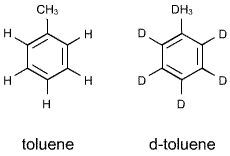Internal standard (IS) calibration
... is the most commonly used calibration method in environmental organic trace analysis
... is not susceptible to systematic errors due to signal drift, matrix effects, and analyte loss
... relies on the use of a surrogate standard (SS)
The surrogate standards is a chemical that ...
... exhibits a 'behavior' during sample preparation that is very similar to the 'behavior' of the analyte
... but is, at the same time, analytically distinguishable from the analyte
examples: 
Best internal standard: deuterated analyte However, needs mass selectable detection (mass spectrometry). |
 |






